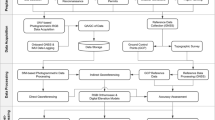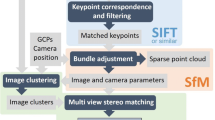Abstract
Terrestrial laser scanners (TLS) are being used for acquisition of 3D data in real time at much faster speed as compared to conventional surveying techniques and thus are considered as a technology making paradigm shift in 3D surveying. Use of TLS by surveyors in large scale surveying is limited due to non-availability of standardized technological guiding principles for deciding the scanning geometry elements like range, resolution, and scanner location beforehand. Resolution is the more critical element because it dictates the others. In order to achieve optimal use of TLS for surveying applications, mathematical models has been proposed for different topographic surface configurations for determining the most appropriate inter point spacing which is a prerequisite for mapping at required level of detail (LOD), which renders an optimized scanner location and resolution. The mathematical models have been tested by field experimentations on different surface configurations and results presented for different scenarios. The results validate the mathematical models; hence, these can be used in discovering best suitable locations beforehand conforming to the required spatial density and thus economizing the overall surveying efforts and related costs.















Similar content being viewed by others
Data availability statement
All data, models, and code generated or used during the study appear in the submitted article.
References
Boehler W, Vicent MB, Marbs A (2003) Investigating laser scanner accuracy. Int Arch Photogramm Remote Sens Spat Inf Sci 34(Part 5):696–701
Brie D, Bombardier V, Baeteman G, Bennis A (2016) Local surface sampling step estimation for extracting boundaries of planar point clouds. ISPRS J Photogramm Remote Sens 119:309–319
Bryan P, Barber D, Mills J (2004) Towards a standard specification for terrestrial laser scanning in cultural heritage–one year on. Int Arch Photogramm Remote Sens Spat Inf Sci 35(B7):966–971
Gallay M, Lloyd CD, McKinley J, Barry L (2013) Assessing modern ground survey methods and airborne laser scanning for digital terrain modelling: a case study from the Lake District, England. Comput Geosci 51:216–227
González-Jorge H, Riveiro B, Armesto J, Arias P (2011) Standard artifact for the geometric verification of terrestrial laser scanning systems. Opt Laser Technol 43(7):1249–1256
Google (n.d.) [Google Earth image of football ground and parade ground in UTM skudai]. Retrieved from https://earth.google.com/download-earth.html on August 31, 2018
Kawashima K, Yamanishi S, Kanai S, Date H (2014) Finding the next-best scanner position for as-built modeling of piping systems. Int Arch Photogramm Remote Sens Spat Inf Sci 40(5):313
Kim M-K, Li B, Park J-S, Lee S-J, Sohn H-G (2014) Optimal locations of terrestrial laser scanner for indoor mapping using genetic algorithm. In: Paper presented at the Control, Automation and Information Sciences (ICCAIS), 2014 International Conference on, pp 140–143
Latimer E, Latimer D, Saxena R, Lyons C, Michaux-Smith L, Thayer S (2004) Sensor space planning with applications to construction environments. In: Paper presented at the Robotics and Automation, 2004. Proceedings. ICRA'04. 2004 IEEE International Conference on, vol 5, pp 4454–4460
Lichti DD (2004) A resolution measure for terrestrial laser scanners. Int Arch Photogramm Remote Sens Spat Inf Sci 34(Part XXX):6
Lichti DD (2010) A review of geometric models and self-calibration methods for terrestrial laser scanners. Bol Ciências Geodésicas 16(1)
Lichti DD, Jamtsho S (2006) Angular resolution of terrestrial laser scanners. Photogramm Rec 21(114):141–160
Lindenbergh R, Pfeifer N, Rabbani T (2005) Accuracy analysis of the Leica HDS3000 and feasibility of tunnel deformation monitoring. In: Paper presented at the Proceedings of the ISPRS Workshop, Laser scanning, vol 36, p 3
Luh LC, Setan H, Majid Z, Chong AK, Tan Z (2014) High resolution survey for topographic surveying. In: Paper presented at the IOP Conference Series: Earth and Environmental Science
Pejić M (2013) Design and optimisation of laser scanning for tunnels geometry inspection. Tunn Undergr Space Technol 37:199–206
Pesci A, Teza G, Bonali E (2011) Terrestrial laser scanner resolution: Numerical simulations and experiments on spatial sampling optimization. Remote Sens 3(1):167–184
Pinkerton M (2011) Terrestrial laser scanning for mainstream land surveying. Surv Q 300(65):7
Soudarissanane, Lindenbergh (2011) Optimizing terrestrial laser scanning measurement set-up. Paper presented at the ISPRS Workshop Laser Scanning 2011, Calgary, Canada, 29-31 August 2011, IAPRS, XXXVIII (5/W12), 2011
Soudarissanane, Lindenbergh, Gorte B (2008) Reducing the error in terrestrial laser scanning by optimizing the measurement set-up. Proceedings of International Archives of Photogrammetry, Remote Sensing and Spatial Information Sciences. pp 3–11
Soudarissanane, Lindenbergh R, Menenti M, Teunissen P (2011) Scanning geometry: influencing factor on the quality of terrestrial laser scanning points. ISPRS J Photogramm Remote Sens 66(4):389–399
Tang P, Alaswad FS (2012) Sensor modeling of laser scanners for automated scan planning on construction jobsites. In: Paper presented at the Construction Research Congress 2012: Construction Challenges in a Flat World
Topcon (2018) Topcon Positioning Systems, Inc. Retrieved from https://www.topconpositioning.com/mass-data-and-volume-collection/laser-scanners/gls-2000 on May 27, 2017
Wujanz, Holst C, Neitzel F, Kuhlmann H, Niemeier W, Schwieger V (2016a) Survey configuration for terrestrial laser scanning. Allgemeine Vermessungsnachrichten (AVN) 6(2016):158–169
Wujanz D, Mettenleiter M, Burger M, Neitzel F (2016b) Viewpoint planning for terrestrial laser scanning utilising an intensity based stochastic model. In: Paper presented at the 3rd Joint International Symposium on Deformation Monitoring (JISDM)
Author information
Authors and Affiliations
Corresponding author
Rights and permissions
About this article
Cite this article
Mahmood, S., Majid, Z. & Idris, K.M. Terrestrial LiDAR sensor modeling towards optimal scan location and spatial density planning for 3D surveying. Appl Geomat 12, 467–480 (2020). https://doi.org/10.1007/s12518-020-00320-9
Received:
Accepted:
Published:
Issue Date:
DOI: https://doi.org/10.1007/s12518-020-00320-9




